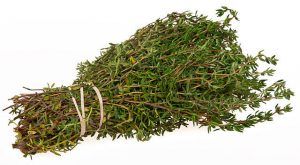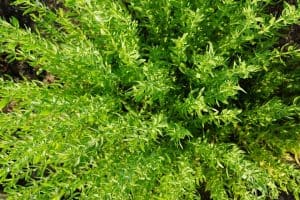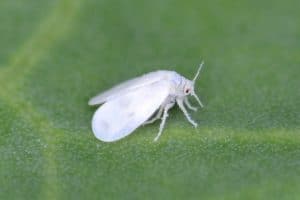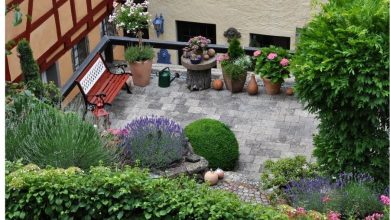How to Plant Thyme in 12 Steps [Guide + Images]

Important points for Planting Thyme:
- When? Late spring.

- Where? In a well-lit place, with direct sun. The temperature should be between 15 – 30 ºC.
- Harvest time? From late spring to early fall.
- How do we prepare the land? The optimal pH ranges between 7.0 and 7.5. It needs dry and alkaline soils.
- How often do we water? It is a plant that does not need much watering.
- How do we sow? The sowing method is broadcast, which means that the seeds are spread throughout the land on a regular basis.
- When do we harvest? During the flowering season of the plant.
- What good associations do you have? Any other plant, although it favors cabbage a lot as it protects it from the cabbage worm.
- Diseases and pests? Thrips, powdery mildew and mildew.
Thyme, Thymus vulgaris, is native to the Mediterranean and belongs to the Labiatae family, just like rosemary, basil or mint. It is a perennial aromatic shrub that can reach 40 cm in height.
Is aaromatic herb and medicinal herb very easy to growIn addition to providing great benefits.
What do we need to plant thyme?
When should it be sown? The dates
It is recommendedits cultivation during the spring. Thyme can be sown from February in warm areas, and from April in colder regions.
Where? The temperature and the light
It resists frost and drought well, but not excessive humidity.
The optimal temperature for cultivation is between 15 and 30 ºC. However, it withstands frost very well, down to -10ºC.
It is favorable for their growth to locate them ina well-lit site with direct sun. However, they tolerate a little shade during the day well, as long as it is not absolute. They prefer midday lighting.
How often and how should it be watered?
It is a plant that does not need much watering. In fact, it is preferable that the risks are scarce than that we exceed ourselves with the water. Excess moisture encourages the growth of fungi that are harmful to the plant.
How do we prepare the land?
 Thyme needs dry and alkaline soils, with good drainage, since it does not tolerate waterlogging.
Thyme needs dry and alkaline soils, with good drainage, since it does not tolerate waterlogging.
It adapts well to rich alluvial and calcareous soils, and also to clayey, light and siliceous ones.
The optimal pH ranges between 7.0 and 7.5.
What are the most favorable associations for the cultivation of thyme?
Its proximity to other plants will help keep insects and pests away.
Above all, it favors cabbage, since it protects them from the cabbage worm.
How to plant thyme step by step
1. Clear the ground
 Extracts weeds and remains of previous cropsand all sorts of debris to ensure your thyme receives the proper amount of nutrients.
Extracts weeds and remains of previous cropsand all sorts of debris to ensure your thyme receives the proper amount of nutrients.
All plants must be pulled out by the roots to prevent them from growing back.
2. Prepare the ground
Moisten the soil before planting. This will prevent the seeds from shifting easily
Fertilize the soil. It spreads a layer of organic matter over the soil. Well passed manure is recommended.
3. Put the seeds in the soil
 The sowing method is broadcast, which is to say that the seeds are spread throughout the land on a regular basis.
The sowing method is broadcast, which is to say that the seeds are spread throughout the land on a regular basis.
Create furrows on the ground, leaving half a meter between each row. Then spread the seeds evenly over the soil and lightly cover them with soil.
Bury them 1.5 cm deep and cover them lightly.
4. Water the soil regularly
It is recommended that you water when you see that the upper layers of the earth have dried.
5. Select the healthiest and strongest seedlings
The seeds will germinate in four weeks.. If more than one seed has germinated in each hole, keep the strongest one. To do this, do not pull the weak one, as you can damage the leaves. A simple pruning at ground level is sufficient.
Preferably, perform this task when the plant is about 15 cm tall. In this way, you guarantee the integrity of each plant.
Once they have reached 30 centimeters in height, the plants will be strong and self-sufficient, and will grow faster.
6. Protect your plant and give it good maintenance
 Check your plants regularly; this to prevent them from contracting pests and other diseases. If you like, you can apply a fungicidal spray to counteract mildew.
Check your plants regularly; this to prevent them from contracting pests and other diseases. If you like, you can apply a fungicidal spray to counteract mildew.
You can also put up a chain link mesh to protect the plants while they are growing.
Although it is not essential, you can feed your thyme with an organic fertilizer such as worm castings to ensure that it has the necessary nutrients.
How to harvest thyme
You can harvest fresh leaves, during the flowering season of the plant, this is fromlate spring to early fall.
Cut the branches, leaving a few centimeters to allow a new flowering. It is advisable to harvest on dry days, with very little humidity in the environment.
Never harvest more than 1/3 of the leaves at a time.
Thyme pests and diseases
Thyme is not usually a victim of insects or pests. However, when it is watered poorly, there is a risk of snails appearing.
Other pests that can be affected by are:
thrips
To combat thrips, a combined application of neem extract and potassium soap is recommended.
White fly
 It is recommended to spray the underside of the leaves with 1 % potassium soap with rain or distilled water.
It is recommended to spray the underside of the leaves with 1 % potassium soap with rain or distilled water.
powdery mildew
It is best to install a drip irrigation system and apply horsetail as prevention.
It also works to eliminate weeds and crop debris, as well as promote ventilation of the crop.
Mildew
To combat it, it is recommended to eliminate weeds and crop debris.
Likewise, excess humidity should be avoided, ventilating the crop.
Horsetail extract or dusted sulfur can also be applied.
[crp limit=”5″ heading=”1″]


![Photo of Poisonous Plants: [The 30 Most Dangerous in the World]](https://www.complete-gardening.com/wp-content/uploads/2022/08/poisonous-plants-the-30-most-dangerous-in-the-world-390x220.png)
![Photo of Kalanchoe cuttings: [Grafting, Season, Rooting and Sowing]](https://www.complete-gardening.com/wp-content/uploads/2021/06/Esquejes-de-Kalanchoe-390x220.jpg)
![Photo of What Care Does Bamboo Have?: [Composting and Pruning]](https://www.complete-gardening.com/wp-content/uploads/2022/08/what-care-does-bamboo-have-composting-and-pruning-390x220.jpg)